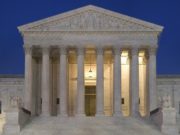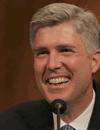UPDATE:
The Supreme Court at its Friday Conference will review a petition in an important First Amendment case, The Real Truth About Abortion v Federal Election Commission.
Allen Dickerson, Legal Director of the Center for Competitive Politics (CCP), has written a short backgrounder on the importance and implications of this case. It appears below and is posted here.
The Supreme Court’s Docket:
The Real Truth About Abortion v Federal Election Commission
by Allen Dickerson
The Supreme Court is considering a certiorari petition that could profoundly affect how non-profit organizations that engage in issue advocacy are regulated by the federal government. The case concerns a fundamental question of constitutional law: under what circumstances may the government require groups to register themselves before engaging in public speech?
The petition – filed by The Real Truth About Abortion, Inc. on September 10, 2012 – argues that the Federal Election Commission’s regulations defining political-committee status violate the First Amendment because they are overly broad, vague, and subjective. As a result, organizations cannot know, with certainty and in advance, whether their activities are subject to FEC regulation. Without this certainty, groups may be reluctant to discuss issues or elected officials, even where those discussions should not be regulated by the FEC, because they cannot reliably avoid surprise prosecutions or politically motivated complaints.
The petition asks the Supreme Court to invalidate regulations that fail to impose bright-line, predictable rules governing political committee status under federal law.
Background
The Real Truth About Abortion, Inc. (“RTAA”) is a non-profit corporation organized under Section 527 of the federal tax code. As a 527 “political organization,” RTAA may raise and spend unlimited funds, and may obtain those funds from any source. It must disclose its contributions and expenditures to the IRS in regular, public reports, and may not advocate for the election or defeat of candidates for office.
RTAA wishes to communicate with the general public, engaging in what it sees as a discussion of the issue of abortion as opposed to explicitly supporting or opposing particular candidates. Its articles of incorporation give its mission as, in part, “provid[ing] accurate and truthful information about the public policy positions of Barack Obama and other pro-abortion candidates for federal office.” Those same articles prohibit RTAA from making contributions to candidates or “expressly advocate[ing] the election or defeat of any clearly identified candidate for public office.”
RTAA wishes to avoid becoming a political committee (usually abbreviated “PAC”) under federal law. PACs have limitations on what they can say in fundraising appeals and their ability to communicate with officeholders. They must register with the federal government before communicating with the public and cannot dissolve without approval of the government. They are required to make extensive reports to the Federal Election Commission (“FEC”) and comply with literally hundreds of pages of regulations. The Supreme Court has noted that PACs “are expensive to administer and subject to extensive regulations.” While the burdens of PAC regulation are appropriate in certain cases, principally where an organization exists mainly to explicitly influence elections, no such justification exists for regulating organizations that engage in issue advocacy. This has been the law since the 1976 decision in Buckley v. Valeo.
An organization becomes a PAC under federal law if it makes at least $1,000 annually in contributions to candidates or spends $1,000 annually in “expenditures” – that is, communications that “expressly advocate” the election or defeat of a clearly-identified candidate.
Issues
1. What qualifies as speech “expressly advocating” the election or defeat of a clearly-identified candidate?
Because “express advocacy” converts a communication into an “expenditure,” and because $1,000 of expenditures converts a group into a political committee – with limits on how that $1,000 could originally have been raised and what laws the organization must follow – it is vital that organizations know, in advance, whether a particular communication is express advocacy.
The FEC has two definitions of “express advocacy.” RTAA accepts the first of these: communications that contain “individual word(s), which in context can have no other reasonable meaning than to urge the election or defeat” of a candidate. The regulation – 11 CFR 100.22(a) – gives numerous examples. These include “vote for the President,” “Smith for Congress,” and “‘vote Pro-Life’ or ‘vote Pro-Choice’ accompanied by a listing of clearly identified candidates described as Pro-Life or Pro-Choice.”
But RTAA is afraid that FEC’s second definition (found at 11 CFR 100.22(b)) is so broad and subjective that no organization can know in advance whether its issue speech will be considered express advocacy. Indeed, there is a split between federal appeals courts that have upheld that section and those that have found it unconstitutional.
11 CFR 100.22(b) asks regulators to look at a communication “taken as a whole and with limited reference to external events,” as opposed to concentrating on express “words” of advocacy. The communication is then express advocacy if it:
could only be interpreted by a reasonable person as containing advocacy of the election or defeat of one or more clearly identified candidate(s) because:
(1) The electoral portion of the communication is unmistakable, unambiguous, and suggestive of only one meaning; and
(2) Reasonable minds could not differ as to whether it encourages actions to elect or defeat one or more clearly identified candidate(s) or encourages some other kind of action.
The difficulty is that no one, including the FEC, can reliably determine what many of these terms mean, including especially “limited reference to external events,” “electoral portion,” “encourages” and “actions to elect or defeat” versus “some other kind of action.”
Last year two organizations asked the FEC for guidance on whether proposed advertisements would be deemed express advocacy. In the National Defense Committee Advisory Opinion, the FEC ruled that three of seven proposed ads were not express advocacy, but could not agree on the status of four other proposed ads. A Wyoming group known as Free Speech also obtained an Advisory Opinion from the FEC. There, two ads were deemed express advocacy, four were not, and the FEC “could not approve a response” for a further five.
Consequently, RTAA believes the Supreme Court should invalidate 11 CFR 100.22(b), leaving in place the more clear-cut and textually-grounded test found at 11 CFR 100.22(a).
2. How should the “major purpose test” for political committees be applied to organizations that principally engage in discussions of issues, as opposed to candidacies?
As part of its effort to protect public discussion of issues, the Supreme Court in Buckley v. Valeo imposed the “major purpose” test for political committees. That is, an organization may not – as a matter of constitutional law – qualify as a PAC (with the limitations and burdens such status implies) unless it is either controlled by a candidate, or has as its “major purpose” the election or defeat of clearly-identified candidates.
The FEC has taken the position that a group’s major purpose is a “fact intensive inquiry” that requires an investigation into all aspects of an organization’s activities, including not only its organizing documents and expenditures, but also public statements and internal communications. No list of specific factors, nor their weighting, has been approved by the FEC. In Wisconsin Right to Life v. FEC, the Supreme Court noted that such fact intensive inquiries themselves both chilled and delayed speech, and should be avoided.
RTAA believes the FEC’s approach is subjective, unpredictable, and intrusive, and consequently will chill protected political speech by those who do not wish to open themselves up to an invasive FEC investigation. It suggests the agency be required to adhere to the clear-cut standard of Mass. Citizens for Life v. FEC, where the Supreme Court noted that “major purpose” can be deduced from either (1) an organization’s organizational documents, such as articles of incorporation or bylaws, or (2) the quantity of federally-regulated expenditures as compared with an organization’s overall budget.
Conclusion
Regardless of the outcome of this petition, RTAA will be subject to a number of registration and disclosure requirements. RTAA will be identified in its communications and will regularly report its donors to the IRS, which will make that information available on its website. And regardless of the Supreme Court’s decision, if RTAA were to run an ad urging the election or defeat of a candidate, it would be subject to FEC disclosure rules as well. Fundamentally, then, this case is not about disclosure.
Rather, the issue before the Court is whether, in order to discuss important political issues and to characterize or even mention the position of officeholders on those issues, American citizens should have to register with the government and comply with burdensome and expensive PAC regulations.














